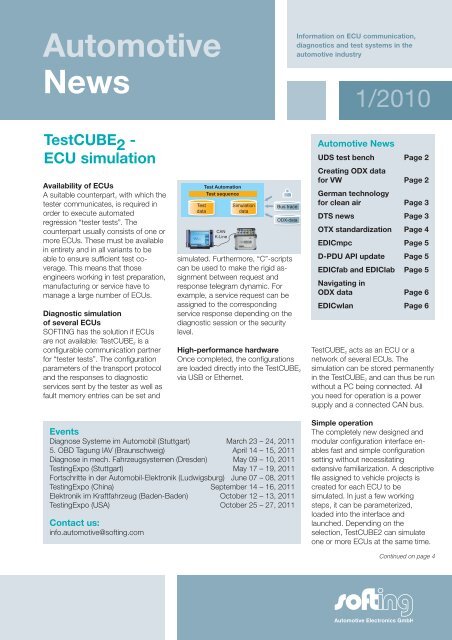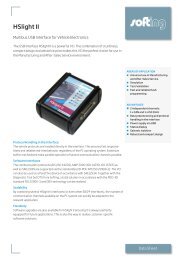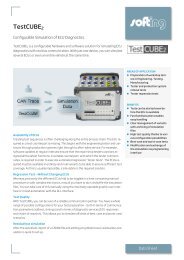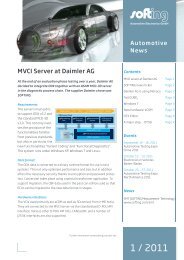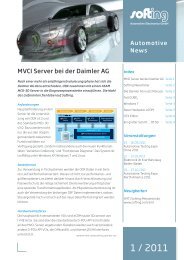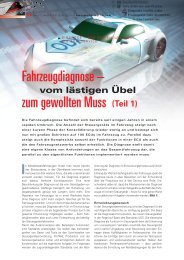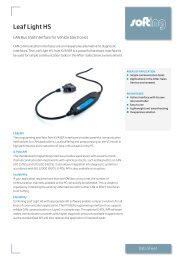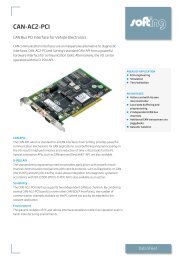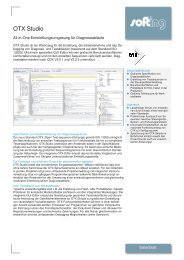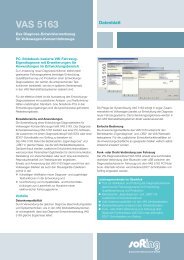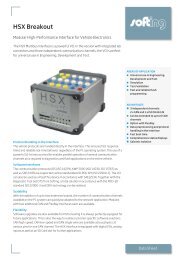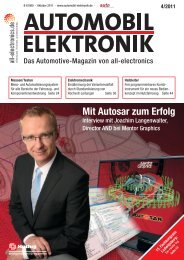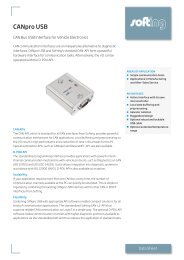Automotive News 1/2010 - Softing Automotive Electronics GmbH
Automotive News 1/2010 - Softing Automotive Electronics GmbH
Automotive News 1/2010 - Softing Automotive Electronics GmbH
Create successful ePaper yourself
Turn your PDF publications into a flip-book with our unique Google optimized e-Paper software.
<strong>Automotive</strong><br />
<strong>News</strong><br />
Information on ECU communication,<br />
diagnostics and test systems in the<br />
automotive industry<br />
1/<strong>2010</strong><br />
TestCUBE 2 -<br />
ECU simulation<br />
Availability of ECUs<br />
A suitable counterpart, with which the<br />
tester communicates, is required in<br />
order to execute automated<br />
regression “tester tests”. The<br />
counterpart usually consists of one or<br />
more ECUs. These must be available<br />
in entirety and in all variants to be<br />
able to ensure sufficient test coverage.<br />
This means that those<br />
engineers working in test preparation,<br />
manufacturing or service have to<br />
manage a large number of ECUs.<br />
Diagnostic simulation<br />
of several ECUs<br />
SOFTING has the solution if ECUs<br />
are not available: TestCUBE 2 is a<br />
configurable communication partner<br />
for “tester tests”. The configuration<br />
parameters of the transport protocol<br />
and the responses to diagnostic<br />
services sent by the tester as well as<br />
fault memory entries can be set and<br />
Test<br />
data<br />
Test Automation<br />
Test sequence<br />
CAN<br />
K-Line<br />
Simulation<br />
data<br />
Bus trace<br />
ODX-data<br />
simulated. Furthermore, “C”-scripts<br />
can be used to make the rigid assignment<br />
between request and<br />
response telegram dynamic. For<br />
example, a service request can be<br />
assigned to the corresponding<br />
service response depending on the<br />
diagnostic session or the security<br />
level.<br />
High-performance hardware<br />
Once completed, the configurations<br />
are loaded directly into the TestCUBE 2<br />
via USB or Ethernet.<br />
<strong>Automotive</strong> <strong>News</strong><br />
UDS test bench Page 2<br />
Creating ODX data<br />
for VW Page 2<br />
German technology<br />
for clean air Page 3<br />
DTS news Page 3<br />
OTX standardization Page 4<br />
EDICmpc Page 5<br />
D-PDU API update Page 5<br />
EDICfab and EDIClab Page 5<br />
Navigating in<br />
ODX data Page 6<br />
EDICwlan Page 6<br />
TestCUBE 2 acts as an ECU or a<br />
network of several ECUs. The<br />
simulation can be stored permanently<br />
in the TestCUBE 2 and can thus be run<br />
without a PC being connected. All<br />
you need for operation is a power<br />
supply and a connected CAN bus.<br />
Events<br />
Diagnose Systeme im Automobil (Stuttgart) March 23 – 24, 2011<br />
5. OBD Tagung IAV (Braunschweig) April 14 – 15, 2011<br />
Diagnose in mech. Fahrzeugsystemen (Dresden) May 09 – 10, 2011<br />
TestingExpo (Stuttgart) May 17 – 19, 2011<br />
Fortschritte in der Automobil-Elektronik (Ludwigsburg) June 07 – 08, 2011<br />
TestingExpo (China) September 14 – 16, 2011<br />
Elektronik im Kraftfahrzeug (Baden-Baden) October 12 – 13, 2011<br />
TestingExpo (USA) October 25 – 27, 2011<br />
Contact us:<br />
info.automotive@softing.com<br />
Simple operation<br />
The completely new designed and<br />
modular configuration interface enables<br />
fast and simple configuration<br />
setting without necessitating<br />
extensive familiarization. A descriptive<br />
file assigned to vehicle projects is<br />
created for each ECU to be<br />
simulated. In just a few working<br />
steps, it can be parameterized,<br />
loaded into the interface and<br />
launched. Depending on the<br />
selection, TestCUBE2 can simulate<br />
one or more ECUs at the same time.<br />
Continued on page 4<br />
<strong>Automotive</strong> <strong>Electronics</strong> <strong>GmbH</strong>
<strong>Automotive</strong> <strong>News</strong> 1/<strong>2010</strong> 2<br />
Ready for SOP thanks to UDS test bench<br />
Virtually every newly developed ECU<br />
uses the UDS protocol for diagnostics.<br />
As the UDS protocol<br />
unites a number of functions from<br />
older diagnostic protocols, the effort<br />
involved in implementing the diagnostic<br />
functionality and the effort<br />
involved in ensuring software ready<br />
for series manufacturing increases<br />
accordingly. In addition to the pure<br />
UDS protocol level, a huge range of<br />
application-specific requirements has<br />
to be taken into consideration in<br />
terms of diagnostic implementation.<br />
The most important ones include:<br />
Session handling<br />
DTC handling, reset behavior<br />
Security access<br />
Functional addressing<br />
ECU reset<br />
SOFTING’s UDS test bench is a test<br />
system that implements the UDS test<br />
specification of the VOLKSWAGEN<br />
Group. The UDS test bench consists of<br />
several components:<br />
TestCASE as the test automation<br />
tool for sequence control and<br />
reporting<br />
DTS-COS for diagnostics and residual<br />
bus simulation<br />
UDS test suite (test cases)<br />
Diagnostic interface EDIC<br />
UDS tests<br />
Layer7 test<br />
Layer5 test<br />
Layer4 test<br />
TestCASE<br />
DTS-COS<br />
EDIC (VCI)<br />
ECU<br />
Test<br />
reports<br />
XLS<br />
HTML<br />
Once a test has been executed,<br />
various test protocols can be<br />
generated that show the test results<br />
as a fast overview as well as in<br />
varying degrees of detail.<br />
Advantages<br />
In comparison to manual test procedures,<br />
the automated test with a<br />
UDS test bench increases the<br />
efficiency and understanding of test<br />
execution and reduces the amount of<br />
time for testing considerably.<br />
The test cases included in the UDS<br />
test bench can easily be adapted to<br />
the UDS test requirements of other<br />
vehicle manufacturers. Furthermore,<br />
the test automation tool used,<br />
TestCASE (now available in Version<br />
4.4), can be implemented as a universal<br />
test automation tool for<br />
function and diagnostic tests in the<br />
HiL environment as well as in other<br />
test environments.<br />
Creating ODX data for VW quickly<br />
and safely<br />
The ODX specification provides an<br />
incredible amount of opportunities in<br />
the designing of an ODX database.<br />
To simplify integration processes, the<br />
OEMs are increasingly relying on<br />
authoring guidelines. These demand<br />
conventions and regulations for standardized<br />
ODX data creation.<br />
<strong>Softing</strong> is currently developing a new<br />
version of DTS-Venice for creating<br />
ODX files in accordance with the<br />
current VW authoring guideline<br />
(special editing mode that can be<br />
activated as an option). The user has<br />
many benefits when using DTS-<br />
Venice:<br />
The early recognition of elementary<br />
breaches of the rules when<br />
creating ODX data can reduce the<br />
number of database tests with the<br />
released ODX checker from<br />
VOLKSWAGEN to a minimum.<br />
The user no longer has to edit<br />
shortnames and the creation of redundant<br />
measurement values, always<br />
subject to error, is prevented.<br />
The incorporation of XML<br />
reference files means text<br />
identifiers that have been applied<br />
for and assigned at VOLKS-<br />
WAGEN can be detected at an<br />
early stage.<br />
In general, the effort involved in<br />
creating the database is<br />
considerably reduced.<br />
From the very beginning, the quality<br />
of the data is thus at a very high level.<br />
Naturally, we are happy to support<br />
you during your first steps and<br />
whenever you have questions.<br />
SOFTING has a qualified support<br />
team to answer any detailed<br />
questions.<br />
For more information take a look at<br />
www.softing.com/venice-en<br />
Young talent gets a head<br />
start<br />
All theories initially have to be<br />
tested in practice.<br />
As a student, take the<br />
opportunity to get to know a wide<br />
range of interesting areas of<br />
activity.<br />
We can offer you thrilling internships,<br />
varied student trainee positions<br />
and pioneering topics for<br />
your final dissertation.<br />
Put your specialist knowledge to<br />
the test. We will develop and<br />
challenge you. Offers at<br />
www.softing.com/karriere
<strong>Automotive</strong> <strong>News</strong> 1/<strong>2010</strong> 3<br />
German technology for clean air<br />
With DTS (Diagnostic Tool Set),<br />
<strong>Softing</strong> is helping Albonair <strong>GmbH</strong><br />
attain legal requirements.<br />
To reduce the air pollution caused by<br />
diesel engines, environmental protection<br />
agencies have ordered a<br />
decrease in the emission of particles<br />
(soot) and nitrogen oxides (NOx). Particle<br />
emission can be reduced by<br />
using diesel particle filters (DPF).<br />
Selective catalytic reduction (SCR) is<br />
regarded as the state-of-the-art technology<br />
for the effective reduction of<br />
nitrogen oxides.<br />
Albonair <strong>GmbH</strong>, based in Dortmund,<br />
gave itself the task of reducing air<br />
pollution caused by diesel engines. It<br />
is a member of the Indian Hinduja<br />
Group, just like Ashok Leyland, one<br />
of the largest manufacturers of<br />
commercial vehicles in India.<br />
Albonair specializes in the development<br />
and manufacture of exhaust<br />
aftertreatment systems. The SCR<br />
method involves injecting the AdBlue<br />
reducing agent into the exhaust tract<br />
to reduce nitrogen oxides. The SCR<br />
system by Albonair consists of an<br />
AdBlue ® doser with Aftertreatment<br />
Control Unit (ACU), the AdBlue ®<br />
tank and the SCR catalytic converter.<br />
SAE J1939 is implemented for<br />
onboard communication between the<br />
SCR ECU and the engine ECU; for<br />
diagnostic communication OBD on<br />
CAN and UDS on CAN.<br />
In order to be future-proof in terms of<br />
upcoming requirements of diesel<br />
engine manufacturers, manufacturers<br />
of commercial vehicles, but also<br />
legislators, Albonair decided to use<br />
standardized software including products<br />
from SOFTING.<br />
The database in ODX format,<br />
generated with the authoring tool<br />
DTS-Venice, is used all along the process<br />
chain (Engineering, Testing, Release,<br />
Manufacturing, After-Sales<br />
Service). Whereas<br />
Engineering involves<br />
extensive manual<br />
testing with DTS-<br />
Monaco, the software<br />
regression test<br />
is automated.<br />
TestCASE, a<br />
product by<br />
SOFTING and our<br />
partner Tracetronic,<br />
is used for test<br />
automation.<br />
The reprogramming<br />
and test station at<br />
the end of line (EOL) uses ODX and<br />
the D-Server DTS-COS and the application<br />
is based on LabView.<br />
For the service tester in the repair<br />
shop, both the ODX database and<br />
the D-Server DTS-COS as well as<br />
individual LabView-VIs can be<br />
reused.<br />
Thanks to <strong>Softing</strong>'s consistent tool<br />
chain, Mr. Adler from Albonair was<br />
able to realize his goal of relying on<br />
standard tools.<br />
For more information take a look at<br />
www.softing.com/dts-automation-en<br />
DTS news – a whole range of function extensions<br />
Many DTS users present us with<br />
challenges that we are happy to<br />
solve! That is why our DTS product<br />
family regularly has extensive<br />
extensions to report.<br />
At the beginning of the year, CBF<br />
support was extended considerably<br />
to ensure that proprietary data processes<br />
are also available in the DTS<br />
quality users have come to expect.<br />
The individual tools have also been<br />
extended:<br />
DTS-COS<br />
The standardized API of our ASAM<br />
D-Server has been given a number of<br />
new functions to give you access to<br />
even more possibilities of the ODX<br />
standard. Furthermore, additional<br />
SOFTING specific API extensions<br />
were documented to provide your<br />
applications with full access<br />
convenience and functionalities that<br />
even surpass the standard.<br />
DTS-Monaco<br />
In addition to the well-known application-oriented<br />
interfaces, the<br />
interface can now display explanations,<br />
for example with graphics<br />
or textual test instructions. Complex<br />
ODX data (e.g. structures, fields,…)<br />
can now also be used in instruments<br />
– a considerable relief as this ensures<br />
you remain independent of the origin<br />
of the ODX data. And the OBD test<br />
interface has also been extended – to<br />
ensure even better coverage of the<br />
legislator’s requirements.<br />
DTS – the entire range of diagnostics<br />
from ECU engineering through to<br />
testing on the vehicle in your daily<br />
work!<br />
For more information take a look at<br />
www.softing.com/dts-en
<strong>Automotive</strong> <strong>News</strong> 1/<strong>2010</strong> 4<br />
OTX – standardized diagnostics under the ISO-flag<br />
As an addition to the established<br />
ODX standard, the OTX standard<br />
(Open Test Sequence Exchange<br />
Format) is currently undergoing ISO<br />
standardization. It enables the<br />
description and transfer of entire test<br />
sequences. This means it is not only<br />
routines, as implemented in ECUs,<br />
that can now be specified in a standardized<br />
manner from the outset. The<br />
sequences can also be loaded into<br />
run-time systems: an executable<br />
specification!<br />
SOFTING plays an active part in standardization<br />
committees and will be<br />
adjusting its well-established tools of<br />
the DTS family and TestCASE<br />
accordingly – hence your investments<br />
are safe with SOFTING!<br />
Request<br />
Response<br />
OTX<br />
ODX<br />
Application<br />
OTX RTE<br />
Run time engine<br />
DTS-COS<br />
D-Server<br />
Continued from page 1<br />
Fast generation of simulation data<br />
In addition to the manual creation of<br />
simulation data, it is also possible to<br />
create simulation data using a bus<br />
trace. In this process, the CAN trace<br />
is automatically searched for diagnostic<br />
messages which are then<br />
assigned to the individual ECUs of<br />
the vehicle. A separate simulation is<br />
generated for every ECU. Dynamic<br />
sequences, such as changing<br />
measured values, different seeds in<br />
the authentication sequence or<br />
response-pending answers, are<br />
simulated in exactly the same way as<br />
the response times of the real ECUs.<br />
The simulation can then be extended<br />
or modified manually. Furthermore,<br />
bus traces can be evaluated and the<br />
resulting diagnostic messages added<br />
to existing simulation data.<br />
Simulation data from the ODX<br />
container<br />
A component that can be used to<br />
create, under user guidance,<br />
simulation data from an ODX<br />
container will be available soon. The<br />
response telegrams are parameterized<br />
and temporarily buffered at<br />
symbolic level. The simulation data is<br />
generated automatically from this<br />
data and can then be downloaded to<br />
the TestCUBE 2 .<br />
Residual bus simulation<br />
To test an ECU that needs to<br />
communicate with other ECUs, it is<br />
possible to execute a residual bus<br />
simulation with TestCUBE 2 . In this<br />
process, messages from ECUs that<br />
do not exist in the network are<br />
simulated. TestCUBE 2 can react to<br />
onboard messages or can send single<br />
or periodic onboard messages, to<br />
the CAN bus. This simulation takes<br />
place in real-time.<br />
Regression tests – without<br />
changing ECUs<br />
Your testers’ regression tests become<br />
much simpler. Whereas previously the<br />
different ECUs had to be toggled in a<br />
time-consuming manual procedure or<br />
with complex electronics, now all you<br />
have to do is exchange the simulation<br />
files. You can do this manually using<br />
the intuitive user interface or in test<br />
automation with the DLL interface.<br />
This allows the simulation of different<br />
ECUs in an automated test.<br />
Negative tests<br />
Particular attention was paid to what<br />
are referred to as negative tests.<br />
These guarantee the robustness of<br />
the tester software using defined or<br />
in some cases non-defined simulated<br />
negative responses. This also enables<br />
the testing of correct timing in<br />
the transport layer and timeouts in<br />
responses to tester requests. This is<br />
not generally all that easy using a real<br />
ECU as it usually only has a fixed<br />
response behavior during testing.<br />
With TestCUBE 2 , you can simulate<br />
any conceivable (and even<br />
unconceivable) error cases. These<br />
negative tests thus result in the final<br />
software being of greater quality.<br />
For more information take a look at<br />
www.softing.com/testcube2-en
<strong>Automotive</strong> <strong>News</strong> 1/<strong>2010</strong> 5<br />
EDICmpc: mobile diagnostics at all times<br />
EDICmpc is a representative of a new<br />
VCI generation of the SOFTING EDIC<br />
family. The EDICmpc is a platform for<br />
flash and diagnostic applications.<br />
Thanks to its extremely ruggedized<br />
design, it is particularly suitable for<br />
use on the road as well as for use in<br />
Manufacturing and in the repair shop.<br />
On the one hand, the EDICmpc is a<br />
PC that is based on the energysaving<br />
Intel ® AtomTM platform and,<br />
on the other, a VCI with the vehicle<br />
interfaces K-line, CAN and LAN. Due<br />
to its dimensions (approx. 184mm x<br />
151mm x 57mm) and the HSDPA<br />
module available as an option, the<br />
EDICmpc is particularly suitable for<br />
use on the road.<br />
D-PDU API update<br />
Since March <strong>2010</strong>, there has been a<br />
new version of the SOFTING D-PDU<br />
API. This version is available as an<br />
update for SOFTING interfaces and<br />
contains the following new features /<br />
improvements:<br />
New protocol ISO 11898_RAW<br />
Revised manual<br />
Revised example program<br />
This means the SOFTING D-PDU API<br />
now supports the following protocols:<br />
KWP 2000 on K-line (only with<br />
EDIC hardware)<br />
KWP 2000 on CAN<br />
UDS on CAN<br />
ISO 11898_RAW<br />
In its basic design, the EDICmpc is<br />
delivered with the SOFTING D-PDU<br />
API (in accordance with ISO 22900-2).<br />
It is also available with the SOFTING<br />
D-Server DTS-COS (in accordance<br />
with ASAM MCD-3 Version 2.0.2) as<br />
a system platform. This means you<br />
can install your own applications on it<br />
and also use it with applications<br />
developed specially for a particular<br />
customer. On this basis SOFTING is<br />
providing several solutions for the<br />
EDICmpc. The standard applications<br />
DTS-Flash (for flash programming)<br />
and DTS-OBD (for OBD diagnostics)<br />
are available. This makes the<br />
EDICmpc the perfect system platform<br />
for flexible use in Engineering, Testing<br />
and Manufacturing.<br />
Key features of the EDICmpc:<br />
Compact design<br />
Ruggedized housing<br />
Operating system: Windows XP<br />
Vehicle interfaces K-line, CAN and<br />
LAN<br />
For more information contact<br />
info.automotive@softing.com<br />
OBD on K-line (only with EDIC<br />
hardware)<br />
OBD on CAN<br />
Various customized protocols are<br />
also available on request.<br />
For more information take a look at<br />
www.softing.com/d-pdu-api-en<br />
Discontinuation of<br />
EDICnet<br />
We discontinued sales on<br />
July 1, <strong>2010</strong>. Details at<br />
www.softing.com/edicnet<br />
EDICfab and EDIClab<br />
Two (un)equal siblings for<br />
the EDIC hardware family<br />
With EDICfab and EDIClab, the product<br />
portfolio of the EDIC hardware<br />
family has been increased by two<br />
high-performance interfaces for use<br />
in Service/Manufacturing and<br />
Engineering/Laboratory.<br />
EDICfab is perfect for use in Service<br />
and Manufacturing thanks to its<br />
ruggedized aluminum profile housing,<br />
the shock-absorbing protective caps<br />
and connectors in accordance with<br />
IP54. The implementation of a<br />
modern 32-bit CPU (PowerPC 384<br />
MHz) has resulted in a highperformance<br />
platform for powerful diagnostic<br />
and flash applications.<br />
The combination of VCI electronics<br />
and the ports of a breakout box in<br />
one device makes EDIClab an innovation<br />
for working in the lab – it is<br />
no longer necessary to have to work<br />
with an additional device and all kinds<br />
of cables. The ECU is connected to<br />
the interface quite simply using<br />
banana plugs. EDIClab has the same<br />
core characteristics as EDICfab and<br />
can be extended by a number of<br />
features. Thanks to the large supply<br />
voltage range of 7 to 36 V, the two<br />
devices can be used in both car and<br />
commercial vehicle sectors. The<br />
galvanic isolation between PC and<br />
vehicle interface makes both VCls<br />
tough enough to cope with the<br />
typical cases of application.<br />
Main features:<br />
D-PDU API (ISO 22900-2)<br />
UDS (ISO 14229-1:2006)<br />
KWP 2000 (ISO 14230, ISO 15765)<br />
2x CAN High-speed / Fault-tolerant<br />
2x K-Line to 250 kBaud<br />
Wake Up on CAN, KL 15<br />
Digital IOs, analog inputs<br />
USB 2.0<br />
WLAN 802.11 b/g
<strong>Softing</strong> <strong>Automotive</strong> <strong>Electronics</strong> <strong>GmbH</strong><br />
Richard-Reitzner-Allee 6<br />
85540 Haar, Germany<br />
Tel.: +49 89 4 56 56-420<br />
Fax: +49 89 4 56 56-499<br />
info.automotive@softing.com<br />
www.softing.com<br />
<strong>Softing</strong> North America, Inc.<br />
29 Water Street, Suite 301<br />
Newburyport, MA 01950<br />
USA<br />
Tel.: +1 978 499 9650<br />
Fax: +1 978 499 9654<br />
info.usa@softing.com<br />
www.softing.us<br />
<strong>Automotive</strong> <strong>News</strong> 1/<strong>2010</strong><br />
Navigating in ODX data<br />
becomes simple and efficient<br />
ODX data is already used extensively<br />
in Manufacturing at AUDI/VW today.<br />
For specifying test scope, test preparation<br />
requires the names of diagnostic<br />
services, parameters and<br />
results. Actual values must be assigned<br />
to the parameters and expected<br />
values to the results. The test<br />
steps are described using a comprehensive<br />
Excel spreadsheet. The<br />
immense quantity of ODX data is the<br />
first challenge. The original process<br />
involved data in PDF format: This<br />
turned out to be virtually unmanageable.<br />
Because to ensure the safe<br />
creation of test specifications without<br />
the danger of typing errors that<br />
meant PDF copy – Excel paste, PDF<br />
copy – Excel paste, ...<br />
The task of improving this procedure<br />
thus entailed:<br />
Step-by-step, user-guided display<br />
of ODX content<br />
A direct link to the systems<br />
creating the test sequences<br />
Together with the AUDI/VW<br />
Manufacturing Department, SOFTING<br />
created the ODX Browser. The ODX<br />
Browser is an independent application<br />
for visualizing ODX data that<br />
can be controlled remotely from the<br />
test sequences with intelligent integration.<br />
The user is presented with<br />
an intuitive top-down view of the data<br />
in the ODX Browser: This shows all<br />
ODX inheritance relations (runtime<br />
view).<br />
Nominal values can be assigned to<br />
parameters in the ODX Browser to<br />
create test sequences. These can be<br />
returned to the system creating the<br />
test sequences together with the<br />
required ODX information at the click<br />
of a button. From the test sequence,<br />
you can also toggle directly to the<br />
selected position in the ODX data<br />
and make a change there. This is<br />
immediately accepted.<br />
AUDI/VW benefit considerably in<br />
terms of speed and security with the<br />
SOFTING ODX Browser when<br />
preparing the test sequences in<br />
Manufacturing. The combination of<br />
machine-readable ODX data and suitable<br />
tool ensures an increase in<br />
quality – notably compared to the<br />
time before ODX as the specification<br />
can be used directly to create test<br />
sequences.<br />
EDIC + wireless + robust = EDICwlan<br />
Ruggedized VCI with connection via WLAN and USB<br />
EDICwlan is based on the tried-andtested<br />
and widely used EDIC<br />
architecture with multi-link software.<br />
Thanks to its ruggedized design, the<br />
device is particularly suitable for use<br />
in Manufacturing, Testing and After-<br />
Sales Service. Notably to Power<br />
Management and the buffering of the<br />
supply voltage via the integrated<br />
power pack in flash programming applications<br />
the change to another<br />
vehicle can be done almost without<br />
loosing any time.<br />
The communication protocols UDS<br />
(ISO 14229-1:2006) and KWP 2000<br />
(ISO 14230, ISO 15765) as well as all<br />
VOLKSWAGEN-specific protocols are<br />
supported via the standardized D-<br />
PDU API. With a software layer based<br />
on the D-PDU API, the VCI can also<br />
be used as a pass-thru device in<br />
accordance with SAE J2534.<br />
Communication to the application PC<br />
takes place via WLAN 802.11 b/g or<br />
via USB V2.0 Full Speed. The data<br />
security necessary for radio operation<br />
is attained via the encryption standards<br />
WEP and WPA2. Both the adhoc<br />
mode and the infrastructure<br />
mode for operation with an access<br />
point are supported.<br />
All necessary settings are taken care<br />
of in just a few easy steps thanks to<br />
an extensive configuration program.<br />
With an input voltage<br />
range from 8 to 32<br />
Volt, EDICwlan can<br />
be used for both<br />
the car and the<br />
commercial<br />
vehicle sectors.<br />
With the solid<br />
aluminum profile and industry-proof<br />
connectors, protection class IP54 is<br />
attained and operation in extremely<br />
rough environments guaranteed.<br />
For more information contact<br />
info.automotive@softing.com<br />
© <strong>Softing</strong> <strong>Automotive</strong> <strong>Electronics</strong> <strong>GmbH</strong>, N_AE_16E_01-11 (Status January 2011)<br />
<strong>Automotive</strong> <strong>Electronics</strong> <strong>GmbH</strong>


